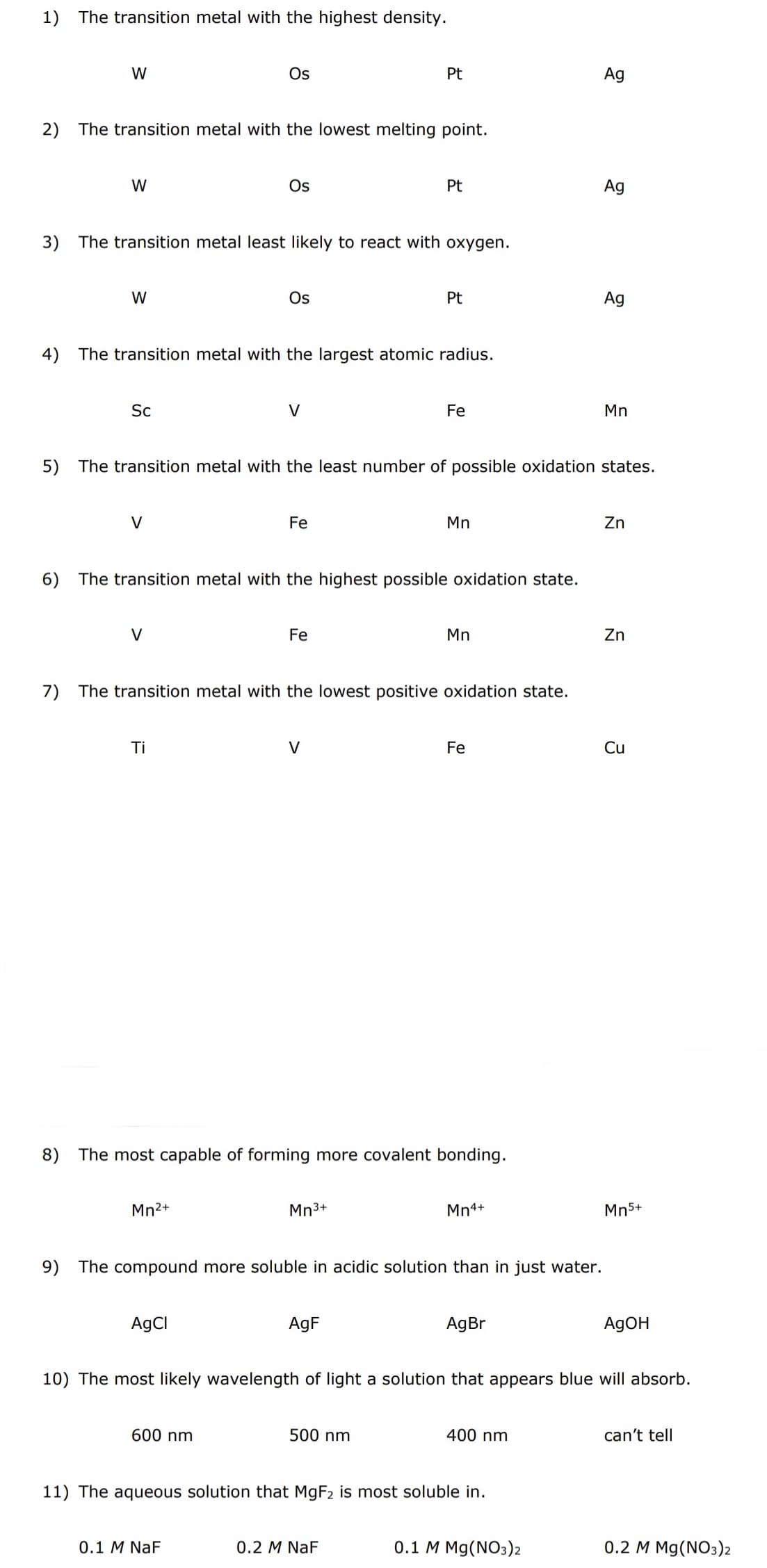Chemistry: Principles and Practice
3rd Edition
ISBN:9780534420123
Author:Daniel L. Reger, Scott R. Goode, David W. Ball, Edward Mercer
Publisher:Daniel L. Reger, Scott R. Goode, David W. Ball, Edward Mercer
Chapter19: Transitition Metals, Coordination Chemistry And Metallurgy
Section: Chapter Questions
Problem 19.7QE
Related questions
Question
I need help with questions 1-11? Could you briefly explain which answer you got for each question?

Transcribed Image Text:1)
The transition metal with the highest density.
W
W
2) The transition metal with the lowest melting point.
W
Sc
3) The transition metal least likely to react with oxygen.
V
V
Os
4) The transition metal with the largest atomic radius.
Ti
Os
Mn²+
Os
AgCl
V
600 nm
5) The transition metal with the least number of possible oxidation states.
Fe
6) The transition metal with the highest possible oxidation state.
0.1 M NaF
Fe
Pt
7) The transition metal with the lowest positive oxidation state.
V
Pt
Mn³+
Pt
8) The most capable of forming more covalent bonding.
AgF
Fe
500 nm
Mn
9) The compound more soluble in acidic solution than in just water.
0.2 M NaF
Mn
Fe
Mn4+
AgBr
11) The aqueous solution that MgF2 is most soluble in.
400 nm
Ag
Ag
0.1 M Mg(NO3)2
Ag
Mn
10) The most likely wavelength of light a solution that appears blue will absorb.
Zn
Zn
Cu
Mn5+
AgOH
can't tell
0.2 M Mg(NO3)2
Expert Solution
This question has been solved!
Explore an expertly crafted, step-by-step solution for a thorough understanding of key concepts.
Step by step
Solved in 3 steps

Knowledge Booster
Learn more about
Need a deep-dive on the concept behind this application? Look no further. Learn more about this topic, chemistry and related others by exploring similar questions and additional content below.Recommended textbooks for you

Chemistry: Principles and Practice
Chemistry
ISBN:
9780534420123
Author:
Daniel L. Reger, Scott R. Goode, David W. Ball, Edward Mercer
Publisher:
Cengage Learning

Chemistry & Chemical Reactivity
Chemistry
ISBN:
9781337399074
Author:
John C. Kotz, Paul M. Treichel, John Townsend, David Treichel
Publisher:
Cengage Learning

Chemistry & Chemical Reactivity
Chemistry
ISBN:
9781133949640
Author:
John C. Kotz, Paul M. Treichel, John Townsend, David Treichel
Publisher:
Cengage Learning

Chemistry: Principles and Practice
Chemistry
ISBN:
9780534420123
Author:
Daniel L. Reger, Scott R. Goode, David W. Ball, Edward Mercer
Publisher:
Cengage Learning

Chemistry & Chemical Reactivity
Chemistry
ISBN:
9781337399074
Author:
John C. Kotz, Paul M. Treichel, John Townsend, David Treichel
Publisher:
Cengage Learning

Chemistry & Chemical Reactivity
Chemistry
ISBN:
9781133949640
Author:
John C. Kotz, Paul M. Treichel, John Townsend, David Treichel
Publisher:
Cengage Learning

Chemistry: The Molecular Science
Chemistry
ISBN:
9781285199047
Author:
John W. Moore, Conrad L. Stanitski
Publisher:
Cengage Learning

Chemistry by OpenStax (2015-05-04)
Chemistry
ISBN:
9781938168390
Author:
Klaus Theopold, Richard H Langley, Paul Flowers, William R. Robinson, Mark Blaser
Publisher:
OpenStax